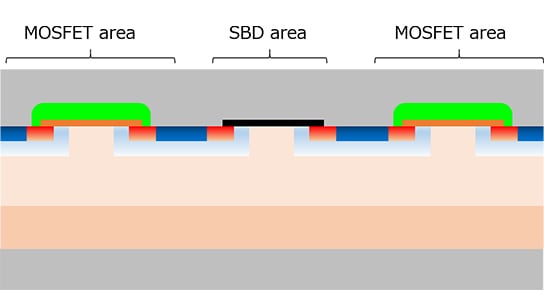Toshiba’s New Device Structure Improves SiC MOSFET Reliability
July 30, 2020
Toshiba Electronic Devices & Storage Corporation
TOKYO--Toshiba Electronic Devices & Storage Corporation (“Toshiba”) today announced a new device structure that improves the reliability of SiC MOSFET [1]. Schottky barrier diodes [2] (SBDs) embedded into the MOSFET realize a structure that improves reliability more than 10 times [3] compared to Toshiba’s typical structure while suppressing any rise in on-resistance.
Power devices are essential components of reducing power consumption in vehicles and industrial and other electrical equipment. Silicon carbide (SiC) is widely anticipated as a next generation material for power devices, as it realizes higher voltages and lower loss than silicon. SiC power devices are now mainly utilized in inverters for trains, but wider application is on the horizon, including in photovoltaic power systems and power management systems for industrial equipment.
The use and market growth of SiC devices have been held back by reliability issues. One of these involves PN diodes [4], which are positioned between a power MOSFET’s power source and drain. Voltage applied to the PN diode energizes it and results in a change of on-resistance that degrades device reliability. Toshiba’s new device structure, SBD-embedded MOSFET, solves this problem.
The new structure prevents energizing of the PN diode by positioning an SBD in parallel to the PN diode inside the cell. Current flows through the embedded SBD because its on-state voltage compared is lower than that of the PN diode, suppressing changes in on-resistance and degradation of the MOSFET’s reliability.
MOSFET with embedded SBD are already in practical use, but only in high-voltage products such, as 3.3kV devices; normally, embedded SBD cause on-resistance to rise to a level that only high-voltage products can tolerate. Toshiba adjusted various device parameters and found that the ratio of SBD area in a MOSFET is the key for suppressing increased on-resistance. By optimizing the SBD ratio, Toshiba realized a highly reliable 1.2kV class SiC MOSFET.
Toshiba plans to start mass production of 1.2kV class SiC MOSFET with the new technology from late August this year.
Details of the new structure were reported in July at PCIM Europe, an international power semiconductor conference held online.
Note
[1] MOSFET: metal-oxide-semiconductor field-effect transistor
[2] Schottky barrier diode: A semiconductor diode formed by the junction of a semiconductor with a metal.
[3] Toshiba defines reliability as a change in on-resistance when a current is applied from the source to the drain of a device at a current density of 250 A/cm2 for 1,000 hours. On-resistance changes by as much as 43% for Toshiba’s typical MOSFET, but it changes by only 3% in an SBD-embedded MOSFET.
[4] PN diode: A diode formed by the pn junction between the source and drain.
The structure of SBD-embedded MOSFET

SBD-embedded MOSFET can suppress a change in on-resistance

Customer Inquiries:
Power Device Sales & Marketing Department
Tel: +81-3-3457-3933
*Company names, product names, and service names may be trademarks of their respective companies.
*Information in this document, including product prices and specifications, content of services and contact information, is current on the date of the announcement but is subject to change without prior notice.